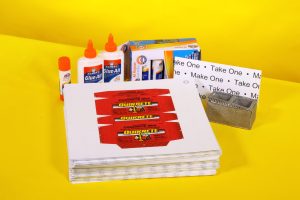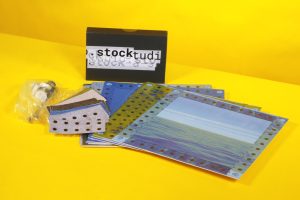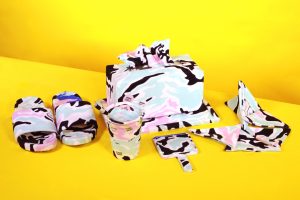February 10, 2020-February 27, 2020
Banvard Gallery, Knowlton School of Architecture, Ohio State University
Ashley Bigham, curator; Outpost Office, exhibition design


Figure 1. T8 Projects – Unpacked. Image Credit: Outpost Office.
Fulfilled is a gathering of forty individual projects, displayed in one long shelving unit. Its simple organization mimics the ubiquitous forms found in Amazon warehouses, big-box shopping aisles, and storage centers spread across the vast territory of the United States. An array of LED tube lights, controlled via nine motion sensors, give an overall ambiance akin to a server center. Individual tags hang from the bottom of the metal-wire shelves, identifying the authors responsible for each material specimen on display. The exhibition, as an object, exists as a contemporary cabinet of curiosities, a loosely organized collection of indexical objects. While historical cabinets reference territories of rare or eclectic natural wonder, this installation curates esoteric inquiries into our current cultural, material, and logistical landscapes of fulfillment.

The prompt given to each participating author makes itself clear upon closer observation; equally sized USPS Flat Rate Priority Boxes dot the shelves, with each project using its volumetric, material, and conceptual bounds as a single unifying constraint. If It Fits, It Ships. The impetus for such a show, as described in Ashley Bigham’s curatorial statement, is driven by the need to reveal the “social, typological, formal, aesthetic, and economic practice[s] constructed collectively through both digital and physical interactions.” This goes beyond the simple tracking codes embedded in the chain of handoffs from client to clerk to mail carrier; it aims to reveal the hidden territories, scalable systems, and tangible objects of our manufactured networks of fulfillment. While the endgame of most fulfillment facilities focuses on efficiency and speed, this exhibition adds a cog to the system, slowing down the rate of exchange to take stock of architecture’s own supply chain.

Figure 3. Fulfilled Poster, digital. Designed by Ingrid Chen. Image Credit: Knowlton School.
For some, the 12 ¼” × 12 ¼” × 6″ box is investigated as a space of constraint. Office of III casts a model in resin, using the box as formwork. EXTENTS shapes a coiled industrial orange cord into a perfectly square, bonsai-inspired lamp. On a nearby shelf, David Eskenazi fills the entire volume with folded packaging paper. Ang Li does the same, but with foam, while Amelyn Ng safely packages another Flat Rate box with an ecosystem of tape and smaller envelopes. All three comment on the material culture of shipment itself. Dylan Krueger’s model portico is shipped in wood excelsior; both packaging and contents refer to a North American vernacular of rural fulfillment. Then there are the deconstructed boxes: Spinagu’s box flips inside out to become a model, while Medium Office’s box becomes a matryoshka containing smaller and smaller versions of the box nested inside.

Figure 4. Ang Li – Packed. Image Credit: Outpost Office.

Figure 5. Dylan Krueger – Packed. Image Credit: Outpost Office.

Figure 6. Medium Office – Unpacked. Image Credit: Outpost Office.
Other, more conventional responses see the box as merely a vessel for transporting work, as seen in the responses from Andrew Kovacs, the Open Workshop, Lluís Alexandre Casanovas Blanco, Germaine Barnes, and others. Laida Aguirre, T+E+A+M, and Besler & Sons reflect on the nature of virtual materials as they each offer interpretations on flattened tectonics. Of the three, Aguirre’s piece warrants a closer look due to its conflation of assembly and material referents, and Besler & Sons’ playful piece invites the visitor to assemble simulacrums of construction materials and tools. Mira Henry of Current Interests offloads previous exhibition posters, using the box as a tool for redistribution, while the LADG offloads unpublished drafts of published essays, finding a reason to display labor. Curtis Roth also reminds us of the value of labor, simply filling the box with stacks of an invoice charging for the time and material it took to produce such an object. Zach Cohen, apparently valuing his time more than any other contributors did, breathed into a paper bag, sealed it shut, and shipped it off. Perhaps his “don’t hold your breath” response to the prompt is an attempt to tell the curator that good work takes time.

Figure 7. Besler & Sons – Unpacked. Image Credit: Outpost Office.

Figure 8. Laida Aguirre – Unpacked. Image Credit: Outpost Office.
The individual reactions to such a prompt showcase a range of conceptual and representational strategies while uncovering the built-in aesthetic biases of their authors. The result is a momentary freeze frame of contemporary architectural practices—a who’s who of small, institutionally aligned designers all attempting to make relevant work in a network of nonstop content production. The act of “commissioning” each office to produce a critical reflection on the theme of industrial logistics, by a curator interested in the formal and economic negotiations of such systems, seems either maniacally cynical or heroically brave. The Capitalocene in which we find ourselves demands things fast and cheap; from raw material to delivery, every step in the supply chain is constantly evaluated for its spatial and temporal efficiency. In a profession that constantly undercuts and undervalues itself, shining light on these subjects ought to offer clues to how we as architects get out of the machine. Instead, the cleanliness of the overall appearance of the exhibition suppresses any metanarrative. There is no archival compendium documenting the embedded energy of each student helper, administrator, dean, janitorial worker, delivery person, lawyer, or fabricator. There is no trace of the piles of cardboard, packaging foam, or wooden offcuts that once existed with their presentable counterparts. And there certainly is no explication on the financial hurdles that a project at this scale must overcome. Extremely limited budgets, while they drive creativity in material procurement, still must account for the nebulous web of exhibition by-products: announcements (both physical and digital), reception food and drinks, and the countless hours spent documenting, editing, and sharing visual outputs.
When asking what it means to be fulfilled, is Bigham referring to the contextually specific American culture of excessive material desire? Or is she subversively commenting on the nature of academic, institutional consumption? Bigham, an assistant professor, hired by Ohio State University, must fulfill her tenure-track requirements of active research—requirements unclearly delimited as publishing, exhibiting, conferencing, and building. Absent from this list (and the show) is evidence of grant writing, patent production, and peer-reviewed research articles—the expected currency of a modern research university. The show then holds a mirror to the present (architectural) institutional desire for academic advancement, satisfied through the proliferation of cheap, buy-it-now content. For Bigham to curate a list of forty architects, all also engaged with academia, laboring tirelessly over their responses, without compensation, is perhaps a mastery of giving the institutions a real bang for their buck. Her project is pure academic fulfillment, one that simultaneously procures the need for and the satisfaction of disciplinary requirement.

Figure 9. Common Accounts – Unpacked. Image Credit: Outpost Office.
Danny Wills is a designer, educator, and researcher. He holds a Bachelor of Architecture from the Cooper Union and a Master of Design Theory and Pedagogy with Distinction from SCI-Arc. Currently he is an adjunct professor at Kent State University. Danny cofounded Space Saloon in 2017, a nonprofit design laboratory dedicated to crafting collaborative hands-on experiences. Space Saloon holds its annual “community-in-residence” festival in Southern California, which acts as a platform for both professional artists and architects, as well as young developing designers, to realize site-specific projects.
How to Cite This: Wills, Danny. Review of Fulfilled, curated by Ashley Bigham, Banvard Gallery, Ohio State Universty, Columbus, OH, February 10–27, 2020, JAE Online, March 6, 2020, http://www.jaeonline.org/articles/review/fulfilled#/.






